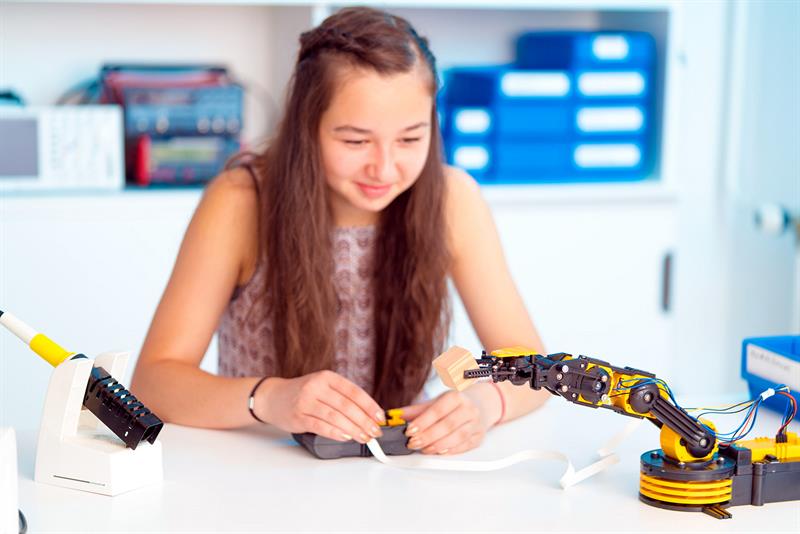In 1984, a pitiful 7% of UK engineering graduates were women. Nearly 30 years later, by 2012/13, this had increased to a still woefully low 14.2%, and by 2016, had reached 15.8%. In the US, women make up about 20% of engineering graduates. In India, the figure is more than 30%.
Not all engineering graduates end up working in engineering, in the UK the percentage of female engineering professionals, the lowest in Europe, was reported at only 9% in 2016. This prompted the “9% is Not Enough” annual conference run by IET, which this year ran on International Women in Engineering Day (INWED).
Broaden the outlook to core STEM degree subjects and we find that women made up just 25% of the total in 2016, the same as in previous years. Slow progress indeed.
In the UK, we are not short of Government and industry initiatives aimed at tackling this challenge. STEM, for example, has succeeded in increasing engineering and technology degree entrants. Targeted specifically at women are the WISE campaign and the Women’s Engineering Society, organiser of INWED. There are others.
But clearly, there is still much work to be done. We need to educate all children, and especially girls, about the huge diversity and value of engineering as a career.We need to encourage girls to choose, and stick with, STEM subjects at school, thereby keeping their engineering career options open. We need to sweep away the stereotypical image of engineering as a male-oriented career choice. And we need to do more to retain engineers once they are working in industry and, for women in particular, we need to ensure there is a valid return ticket after a career break.
Pervading everyday life
Engineering, science and technology pervade our lives in every way. Children are familiar with electronic toys and games, communications devices and the internet from a very young age. Less obvious perhaps, when it comes to career aspirations, is the critical role of engineers in areas such as protecting the environment, healthcare and medicine. Girls too often see only the more visible, traditional, and often male-dominated, links between engineering and construction, transport and manufacturing. We need to correct the misconceptions that girls may have of what it is like to be an engineer. Importantly, we need more female role models.
Tools are in place, but we need to use them more effectively. And this is where we – industry’s engineering employers – can and must contribute more. Support for STEM, for example, can take many useful forms and need not be costly. Consider, for example, support for open days, industry visits and workshops, providing resources (engineers and/or materials) to help schools to incorporate engineering into the curriculum and especially support for STEM ambassadors.

RS5, for example, has announced a partnership with STEM Learning. A recent open day to recruit STEM ambassadors attracted more than 70 volunteers. These ambassadors will use tools such as Raspberry Pi, Arduino, 3D printing and robotics to make workshops fun and inspirational.
RS supported INWED on the day, alongside the University of Northampton. The event attracted around 100 girls (12 to 14 age group). The RS Live Innovation in Motion truck was also there, giving the students the opportunity to see and interact hands-on with the latest technology.
Successful women engineers
There is a raft of examples of successful UK women engineers, highlighted by STEM, WISE, WES and others, who can serve as role models, both young high achievers and those who have reached the top over time. There will be more.
We have recently come across two young female STEM ambassadors. Both have the same passion for engineering, but who came via quite different routes. Chelsea Back, currently studying for an HND in Engineering at Bradford College, discovered that engineering was nothing like she envisaged when she was taken on for work experience. “I became more and more aware of the constant advancements and possibilities within the industry, especially within medical engineering, and I was hooked,” she said. Now she wants to ensure that other young people, especially women who might be put off by the ‘greasy overall’ stereotype, are fully aware of the amazing opportunities that a career in engineering can bring.
Meanwhile, Saloni Chhabra was lucky enough to be encouraged at an early age to pursue science because of the doors it can open to many rewarding careers. “So when it was time to decide, I chose to study electronics,” she explained. Working in the IC design arena for, she has built a strong and broad knowledge base spanning various aspects of IC design flow. “I love to learn and apply new concepts, and am very curious. There is a lot that electronics can help the world achieve – be it self-driven cars or finding cures for diseases.” As a new mother, Chhabra aims to help ensure that the next generation will be even more passionate about science and engineering.
Moving up the career ladder, Ruth Amos, an inspirational young entrepreneur, STEM ambassador and 2006 Young Engineer for Britain, already runs her own company based on her own inventions, and has won numerous awards for motivational speaking as well as engineering achievement. She takes time out to talk to school children, and has set up a YouTube Channel, Kids Invent Stuff, setting monthly challenges to encourage young people in STEM subjects.

Dr Lucy Rogers inspires with a different approach, clearly aimed at demonstrating that engineering can be fun as well as incredibly useful. Whether using Raspberry Pi to reprogram robotic dinosaurs in a theme park, or calculating the probability of collisions between orbiting spacecraft and space junk, she has also developed a talent for communicating the excitement and accessibility of engineering. “I want people to realise than engineering doesn’t have to be about climbing under a car or going down a coal mine. It can be about getting things to do what we want them to do.” Dr Rogers has also been recognised by the Royal Academy of Engineering (RAEng) for her innovative promotion of engineering to the public.
Natural curiosity
Which brings us neatly on to another role model: Dame Prof Ann Dowling, since 2014 the President of the Royal Academy of Engineering. Encouraged from an early age, her natural curiosity about the world took her into studying maths, then engineering. She recognises the importance of changing the mindset of young people, and encouraging girls, in particular, to consider engineering as a career. Under her management, the RAEng has set up a Diversity Leadership Group to help remove barriers and encourage more women into engineering.
Marianne Culver
“Young people should have big dreams,” she has said, and believes that a career in engineering can help them achieve more.
Any and all engineering employers can do more to encourage women engineers, whether it is getting involved with local education, supporting STEM ambassadors, collaborating with Government and institutional organisations on the various campaigns in place, and ensuring that your own company supports gender diversity. As the RAEng reports, there is a strong correlation between companies in the top quartile for gender diversity and higher financial returns than the national industry median.
Author profile
Marianne Culver is president at RS Components.













